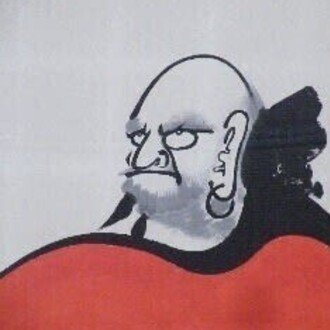
尾道三山のひとつ「西國寺」の天狗伝説 【摩尼山 西國寺<天狗>】 The legend of the Tengu of "Saikoku-ji", one of the three mountains of Onomichi [ Saikokuji Temple ]
天狗。鬼、河童と並ぶ日本三大妖怪の一つといわれながらも、伝説のなかでは大悪事を働くわけではなく、いたずら好きで親しみやすいキャラクターに描かれることが多い。
Tengu. Although it is said to be one of the Three Great Yokai of Japan along with oni(demon) and kappa, it does not do great evil in the legend, and is often depicted as a mischievous and friendly character.
天狗といえば、思い浮かぶのが赤ら顔の「鼻高天狗」。この“鼻高”が高じて “うぬぼれて天狗になって” とか “鼻持ちならない自己中心になって” などと言われ、いまでも比喩的表現として使われている。
言葉表現以外にも、伝説として幼少時代の記憶にあるのが、京の五条大橋の上で弁慶と戦った牛若丸に剣さばきを伝授したのが鞍馬山に棲む天狗だった、という記憶がよみがえってくる。ドラマや漫画では鼻高天狗になっているが、本来の伝説では烏(からす)天狗のようである。
Speaking of tengu, the one that comes to mind is the red-faced "nose-high tengu." This "high nose" is often said to be "conceited and become a tengu" or "become a self-centered person who does not have a nose" and is still used as a metaphorical expression.
In addition to the word expression, the legendary memory of my childhood is that it was the tengu that lived in Kuramayama that taught Ushiwakamaru, who fought Benkei on the Gojo Bridge in Kyoto, to judge the sword. It will come back to life. In dramas and manga, it is a nose-high tengu, but in the original legend, it looks like a crow tengu.
烏天狗は文献によると平安時代ごろまでの呼称で、それ以降は天狗といえば鼻高ということになったようである。
烏天狗は、一説には仏法を守護する八部衆の一つで迦楼羅(カルラ)が変化したものともいわれる。迦楼羅はインド神話に出てくる金色の翼を持ち頭に如意宝珠を頂き、つねに火焔(かえん)を吐き、龍を常食としているとされる巨鳥。奈良の興福寺の八部衆像の迦楼羅には翼が無いが、京都の三十三間堂の二十八部衆像の迦楼羅は一般的な烏天狗のイメージそのものである。(ウィキペディア参照)
According to the literature, karasu(crow) tengu was the name used until around the Heian period, and after that, the tengu was said to have a high nose.
According to one theory, karasu tengu is one of the eight legions that protect Buddhism, and it is said that Karura has changed. Karura is a giant bird that has golden wings that appear in Indian mythology, receives a jewel on its head, always spits flames, and eats dragons as a regular food. Karura, the statue of the Eight Legions at Kofuku-ji Temple in Nara, has no wings, but Karura, the statue of the Eight Legions at Sanjusangendo in Kyoto, is the image of a general karasu tengu. (See Wikipedia)
前置きが長くなったが、本題は先日紹介した「西國寺」の紹介シリーズで、今回は前置きの「天狗」の話である。地元の方や、寺ファンにはよく知られている西國寺の境内にある金剛院の鳥天狗伝説を紹介する。
西國寺の仁王門をくぐり本堂に通じる石段を登って行くと、ちょうど中間当たりの右手に金剛院がある。その金剛院のお堂には烏天狗の面が頭上に飾られている。さらに、お堂の浦に回り込むと石で造られた天狗の面「重軽天狗」が置かれている。願い事をして、軽く持ち上がれば願いがかなうと言われる「重軽さん」と呼ばれ石造りの三体の天狗石や、巨大な烏天狗の作り物がある。
The introduction has become long, but the main subject is the introduction series of "Saikoku-ji" introduced the other day, and this time it is the story of the introduction "Tengu". Introducing the legend of the bird tengu of Kongoin in the precincts of Saikoku-ji, which is well known to locals and temple fans.
Go through the Niomon Gate of Saikoku-ji Temple and climb the stone steps leading to the main hall, and you will find Kongoin on your right in the middle. The face of the karasu tengu is displayed overhead in the temple of Kongoin. In addition, when you go around to the temple, you will find a stone-made tengu mask called "Heavy and Light Tengu". There are three stone tengu stones called "Jyukei-san", who are said to make a wish and lift it up lightly, and a giant karasu tengu.

金剛院

頭上に烏天狗のお面

石像の重軽天狗の頭
江戸時代ではその天狗などを信仰の対象に祀り、天狗の面を背負った白装束の金毘羅道者(行人)が全国を巡って金毘羅信仰を普及した。また、全国各地から讃岐国象頭山金毘羅大権現を詣でる金毘羅参りの際には、天狗の面を背負う習俗も生まれ、深い信仰の対象になったようだ。
修験道は真言宗や天台宗といった密教と密接な関係にあり、しばしば密教寺院が修験者の活動拠点となっている。
In the Edo period, the tengu was enshrined as an object of worship, and the white-clad Konpira-do (goer) who carried the face of the tengu spread the Konpira worship all over the country. In addition, when visiting Konpira, where he visited Konpira Gongen, Mt. Zozu, Sanuki Province from all over the country, the custom of carrying a tengu was born, and it seems that he became an object of deep worship.
Shugendo is closely related to esoteric Buddhism such as Shingon sect and Tendai sect, and esoteric Buddhist temples are often the base of activities for esoteric Buddhists.
尾道三山の千光寺や浄土寺、そして西國寺も真言宗系の寺院として山岳信仰の起点となり多くの行人が訪れていた。西國寺の三重塔の横から「摩尼山霊場巡拝路」の標識にしたがって山道を登ると、巨石信仰の場、磐座(いわくら)といわれているタンク岩が山頂付近にある。
信仰心の篤い人たちは、平安時代から江戸時代にかけ巨岩信仰や天狗信仰という名のもとに四国の金毘羅大権現参りと同じように、尾道の山岳信仰の聖地であった尾道の山々を山伏装束で訪れた。
いまでいうなら各地の寺院巡礼の源流が中四国方面には多く存在している。その一つが尾道であり、ここ西國寺も巡礼ための巨岩や天狗の伝説が残されている。
Senko-ji Temple, Jodo-ji Temple, and Saikoku-ji Temple of Onomichi Sanzan were also the starting points of mountain worship as Shingon Buddhist temples and were visited by many pilgrims. From the side of the three-storied pagoda of Saikoku-ji Temple, follow the sign for " Manizan Sacred Ground Pilgrimage Route”.
From the Heian period to the Edo period, people with a strong faith sank the mountains of Onomichi, which was a sacred place for mountain worship in Onomichi, just like Konpira Gongen in Shikoku under the name of giant rock worship and tengu worship. People visited in costume.
lf you say so far to speak, there are many sources of temple pilgrimages in various places in the Chugoku-Shikoku area. One of them is Onomichi, where the legend of giant rocks and tengu for pilgrimage remains here at Saikoku-ji Temple.
訪れる機会があれば、パワーがもらえるお薦めのスポットなので、ぜひ。
If you have a chance to visit, it is a recommended spot where you can get power, so be sure to check it out.
リポート/ 渡邉雄二 写真/ ネットフリー画像転用 天狗情報/ ウィキペディア情報参照
いいなと思ったら応援しよう!

